
Euclea, from the Greek eukleia meaning "glory and fame", denotes a group of flowering plants in the Ebenaceae or ebony family. They were described as a genus by Linnaeus in 1774. The genus includes evergreen trees and shrubs, native to Africa, the Comoro Islands and Arabia. Several species are used for timber, producing a hard, dark heartwood timber similar to ebony.

Astilbe is a genus of 18 species of rhizomatous flowering plants within the family Saxifragaceae, native to mountain ravines and woodlands in Asia and North America. Some species are known by the common names false goat's beard and false spirea.

Ribes uva-crispa, known as gooseberry or European gooseberry, is a species of flowering shrub in the currant family, Grossulariaceae. It is native to Europe, the Caucasus and northern Africa. Gooseberry bushes produce an edible fruit and are grown on both a commercial and domestic basis. Its native distribution is unclear, since it may have escaped from cultivation and become naturalized. For example, in Britain, some sources consider it to be a native, others to be an introduction. The species is also occasionally naturalized in scattered locations in North America.
The 1983 PBA season was the 9th season of the Philippine Basketball Association (PBA).

The elm cultivar Ulmus 'Crispa' [:'curled', the leaf margin], sometimes known as the Fernleaf Elm, arose before 1800 and was first listed by Willdenow as U. crispa (1809). Audibert listed an U. campestrisLinn. 'Crispa', orme à feuilles crépues [:'frizzy-leaved elm'], in 1817, and an Ulmus urticaefolia [:'nettle-leaved elm'] in 1832; the latter is usually taken to be a synonym. Loudon considered the tree a variety of U. montana (1838). In the 19th century, Ulmus × hollandica cultivars, as well as those of Wych Elm, were often grouped under Ulmus montana. Elwes and Henry (1913) listed 'Crispa' as a form of wych elm, but made no mention of the non-wych samara.
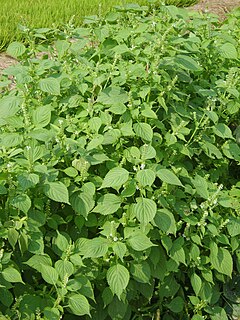
Perilla frutescens, commonly called deulkkae, perilla or Korean perilla, is a species of Perilla in the mint family Lamiaceae. It is an annual plant native to Southeast Asia and Indian highlands, and is traditionally grown in the Korean peninsula, southern China, Japan and India as a crop.
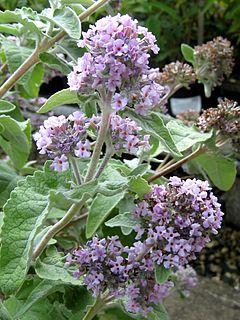
Buddleja crispa, sometimes called the Himalayan butterfly bush, is native to Afghanistan, Bhutan, North India, Nepal, Pakistan and China, where it grows on dry river beds, slopes with boulders, exposed cliffs, and in thickets, at elevations of 1400–4300 m. Named by Bentham in 1835, B. crispa was introduced to cultivation in 1850, and came to be considered one of the more attractive species within the genus; it ranked 8th out of 57 species and cultivars in a public poll organized by the Center for Applied Nursery Research (CANR) at the University of Georgia, US.. In the UK, B. crispa was accorded the Royal Horticultural Society's Award of Merit in 1961. However, the species is not entirely cold-hardy, and thus its popularity is not as ubiquitous as it might otherwise be.
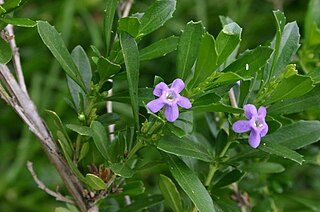
Freylinia tropica is a Southern African shrub with lax, spreading branches and found in the South African province of Limpopo and in Zimbabwe.
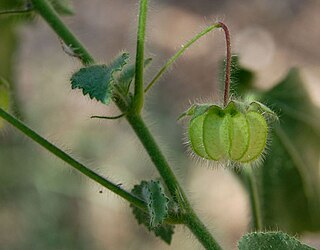
Herissantia is a small genus of flowering plants in the mallow family sometimes referred to as bladder mallows. These are five species of annual and perennial herbs with trailing stems and bladderlike fruits. They are native to the tropical and warm temperate Americas. The most widely distributed species is Herissantia crispa, which can be found on other continents as an introduced species.

Cattleya crispa is a species of orchid indigenous to the Tijuca Mountains north of Rio de Janeiro, Brazil, noted for its crisped and ruffled petals and lip. It is the type species for both the subgenus Cattleya subg. Crispae and its section Cattleya sect. Crispae.
Monardella crispa is a rare species of flowering plant in the mint family known by the common name crisp monardella. It is endemic to California, where it is known only from the sand dunes on the coastline of San Luis Obispo and Santa Barbara Counties.
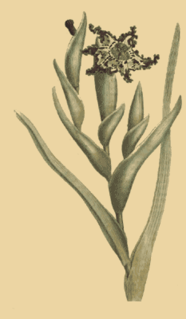
Ferraria crispa is a species of monocotyledonous flowering plant in the family Iridaceae. It is native to South Africa.
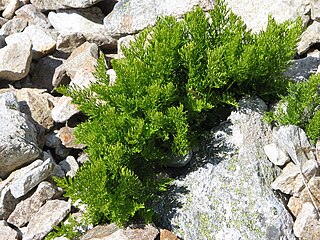
Cryptogramma crispa, the parsley fern, is an Arctic–alpine species of fern. It produces separate sterile and fertile fronds, up to 30 cm (12 in) tall, and is a pioneer species on acidic screes.
Cyanea crispa is a rare species of flowering plant known by the common names crimped rollandia and Koolau Range rollandia. It is endemic to Oahu, where there are no more than fifty individuals remaining in the Koʻolau Range. It is a federally listed endangered species of the United States. Like other Cyanea it is known as haha in Hawaiian.
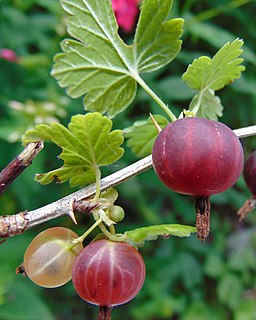
Ribes hirtellum is a species of gooseberry commonly known as wild gooseberry or swamp gooseberry. It is native to Canada and the northern United States. Cultivated gooseberries are derived from this species and from Ribes uva-crispa.

Euclea crispa, commonly known as the blue guarri, is an Afrotropical plant species of the family Ebenaceae. The hardy and evergreen plants may form a dense stand of shrubs, or grow to tree size. It is widespread and common in the interior regions of southern Africa, and occurs northward to the tropics. Though some are present near the South African south and east coasts, they generally occur at middle to high altitudes. It is readily recognizable from its much-branched structure and dull bluish foliage colour. Those bearing lanceolate leaves may however resemble the Wild olive, another common species of the interior plateaus.
Ericameria crispa is a rare North American species of flowering plants in the daisy family. It has been found only on mountain slopes in the state of Utah in the western United States.

Perilla is a genus consisting of one major Asiatic crop species Perilla frutescens and a few wild species in nature belonging to the mint family, Lamiaceae. The genus encompasses several distinct varieties of Asian herb, seed, and vegetable crop, including P. frutescens (deulkkae) and P. frutescens var. crispa (shiso). The genus name Perilla is also a frequently employed common name ("perilla"), applicable to all varieties. Perilla varieties are cross-fertile and intra-specific hybridization occurs naturally. Some varieties are considered invasive.
The elm cultivar Ulmus 'Crispa Pendula', the weeping fernleaf elm, was listed in the Gardeners' Chronicle & New Horticulturist (1873) as Ulmus crispa pendula, a variety of 'Crispa', itself described as "of the U. montana type".













